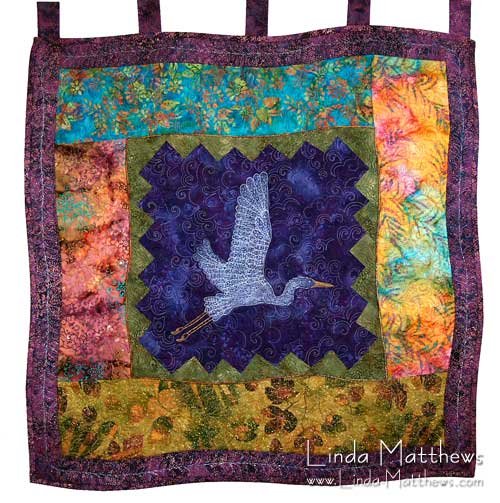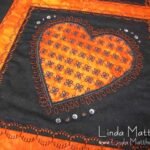Looking for some “fabulous” free motion quilting tips? Then look no further. I’ve been doing free motion for as long as I can remember (and that’s a very long time) and I know some of you struggle with it, so here are my Top Ten favorite tips for free motion ..

#1: the quilt sandwich
Before you begin machine quilting, you should ensure that your quilt is properly sandwiched and basted. Time taken for preparation beforehand will prevent problems occurring during the machine quilting process.
- The backing and the batting should be at least 2″ larger than the quilt top on all sides.
- Press the top and the backing
- Lay out the backing, wrong side up
- Smooth out all the wrinkles
- Lay out the batting on top of the backing and smooth out all the wrinkles
- Center the quilt top, right side up, on top of the batting and smooth out all the wrinkles
- Baste in place
Basting can be done using any of the following methods
basting spray
There are a variety of basting sprays available. For best results, follow the instructions on the can, and always ensure you’re in a well-ventilated area when using basting sprays.
safety pins
Quilter’s safety pins are slightly bent so that they are easy to remove as you’re sewing. Start pinning at one end of the quilt and work your way across and up, folding the quilt if necessary and ensuring that the quilt lays flat and wrinkle-free before you pin. Space the safety pins up to 6″ apart.
hand stitching
Use a long basting needle to hand stitch and the process will go much quicker.
- Baste close to the outer edge of the quilt first and then work across from one side to the other
- If you’re right-handed, work right to left; if you’re left-handed, work left to right
- Backstitch at the end of each row
- Basting lines should be approx 6″ apart
- When you’re done basting across the quilt, rotate the quilt 45 deg and baste across the quilt in that direction also

#2: a good sewing or quilting machine
A good sewing or quilting machine will improve the quality of your machine quilting greatly. A good machine doesn’t have to cost a lot of money, but it should provide at the very least, good quality stitch and tension features.
Make sure you’re familiar with the features of your sewing or quilting machine (that’s right – read the manual), and that you’re comfortable using your machine.
#3: machine feet
Specialty machine feet are designed to assist the machine user in getting the very best quality stitch possible, and using these feet can reduce a lot of problems associated with machine quilting.
walking foot or even feed foot
A walking foot or even feed foot, is helpful when doing straight stitching on bulky fabrics and quilts. This type of foot will provide a straight stitching line with uniform stitch length. Using a quilting bar with the walking foot will assist in stitching evenly spaced rows.
The walking foot, working in unison with the feed dogs, provides a smooth and even feed of the fabric, and assists in preventing the layers of the quilt from shifting.
Some models of quilting and sewing machines come equipped with an in-built even feed, or walking foot. This usually provides easier and better quality stitching than when using a standard walking foot attachment.
free motion foot
A free motion foot should be used when doing free motion quilting. Free motion quilting is normally done with the feed dogs down, however some quilters like to work with the feed dogs up. This is a personal preference and you should take the time to test both methods to determine which one you’re most comfortable with.
The free motion quilting technique can be challenging to master and if you have never done free motion quilting, it’s a good idea to take some classes to learn the technique or at least invest in a book that explains the technique.

#4: needles
It’s important to make sure you’re working with the correct >machine needle for the type of thread that you’re using.
Always make sure your needle is sharp in order to provide the best possible stitch quality. A dull needle will break the fibers of your fabric rather than pierce them, and as a result you can sometimes end up with unsightly broken fibers pushed through to the back of your project.
There is a reason why there are so many different types of needles available; they each serve a different purpose. You can visit the Schmetz Needle website to learn all about the different types of needles that are available.
#5: thread
There are many different types of thread on the market these days, which is such a great thing for quilters – we have a huge selection of types, weights and colors to choose from.
Thread quality is an important issue and you should always use a good quality thread in your sewing machine. It will give you less aggravation when sewing – less thread breakages and jams – and will provide you with a beautiful finish on your sewing project.
Using old thread usually ends in frustration. As thread gets old, it becomes brittle and prone to shredding and no matter what type of needle you use, it’s challenging to find one that will work with this type of thread. Don’t throw out your old thread though, you can use it in your bobbin where it will work much better for you.
A great resource for information about threads can be found at Superior Threads. They not only make a great product, but they also provide valuable information.

#6: tension
Setting the correct tension is very important when machine quilting. As quilters, we sometimes use different weight threads in the top and bobbin, and it then becomes absolutely necessary to adjust your tension in order to achieve a good looking stitch quality.
If you find that adjusting the top tension doesn’t provide a good stitch quality, you will need to adjust the bobbin tension also. If you’re not comfortable adjusting the bobbin tension, purchase a separate bobbin case and use it exclusively for when you need to make adjustments, then you can be sure that you will always have a bobbin case set to factory tension.
#7: tools
There are a number of quilting tools on the market that can be helpful when doing machine quilting.
sewing machine extension table
Sufficient clear table space around your machine is important when working with large quilts as it helps the quilt to move freely. If you do not have a drop in sewing table, then an extension table for your machine is the next best thing. You will be amazed at the difference it makes having extra space, at machine level height, to support your quilt.
quilting gloves
When doing free motion quilting, quilting gloves can greatly improve the manageability of your quilt, whether it’s a large or small quilt. Moving your quilt with ease is an important factor in free motion quilting. It helps to provide a consistency in stitch length and stitch line.
free motion slider
The free motion slider is a tool that provides a slippery surface to your machine bed and assists in the movement of your quilt when doing free motion quilting.
The slider is a teflon sheet, size 8 1/2″ x 11″, that you tape to the top of your machine bed, just under the machine needle. It has a small hole in it to allow movement of the machine needle.
This is a great alternative to using quilting gloves.

#8: transferring designs
There are a number of ways to transfer designs to your quilt.
You can free-hand draw your designs using fabric marking pens which are available in a variety of styles and color, removable by heat, water or air. You can also use marking pens with stencils.
Chalk is a simple marking tool as it brushes away easily and does not leave residue, and pouncing chalk works particularly well with stencils.
You can purchase precut quilting stencils, or make your own. A quick way to make your own stencils is to print out a design onto copy paper using your printer, remove the upper thread from your sewing machine and stitch around the outline, punching holes into the design outline. Use pouncing chalk to transfer the design to your project.
If the smell of pouncing chalk irritates you or causes problems with your breathing, substitute the chalk by using talcum powder for dark colored fabric or cinnamon for light colored fabric. They smell much nicer and brush away just as easily.
#9: posture
Neck, shoulder and wrist tension are problems that most machine quilters will face at some time or another. Sitting at a sewing machine for long periods of time can produce a significant amount of stress, particularly on these areas of your body.
Having your machine set at the appropriate height is one way to reduce shoulder and neck strain. Sewing machine cabinets that allow your machine to drop in and sit flush with the table top are a great way to reduce shoulder strain. Along with a comfortable chair set at the appropriate height.
Free motion quilting seems to produce a lot of strain on these areas, particularly as most of us are so intent on keeping our stitching even and consistent that we tend to ignore the tension building.
Get up and move around often: stretch out your arms and your back, and make sure your body is relaxed before sitting down to sew again.
The more relaxed and comfortable you are, the better sewing results you will achieve.

#10: practice makes perfect
I’m sure you’ve heard this said over and over again, but it really is the only way you will ever get good at machine quilting – practice, practice, practice.
Whether it’s using your walking foot or attempting free motion quilting, practicing often will help you to feel comfortable with both the process and your machine.
Free motion quilting, particularly, requires lots of practice to ensure that the stitching line runs smoothly and the stitch length is somewhat consistent.
Good luck and happy stitching!




